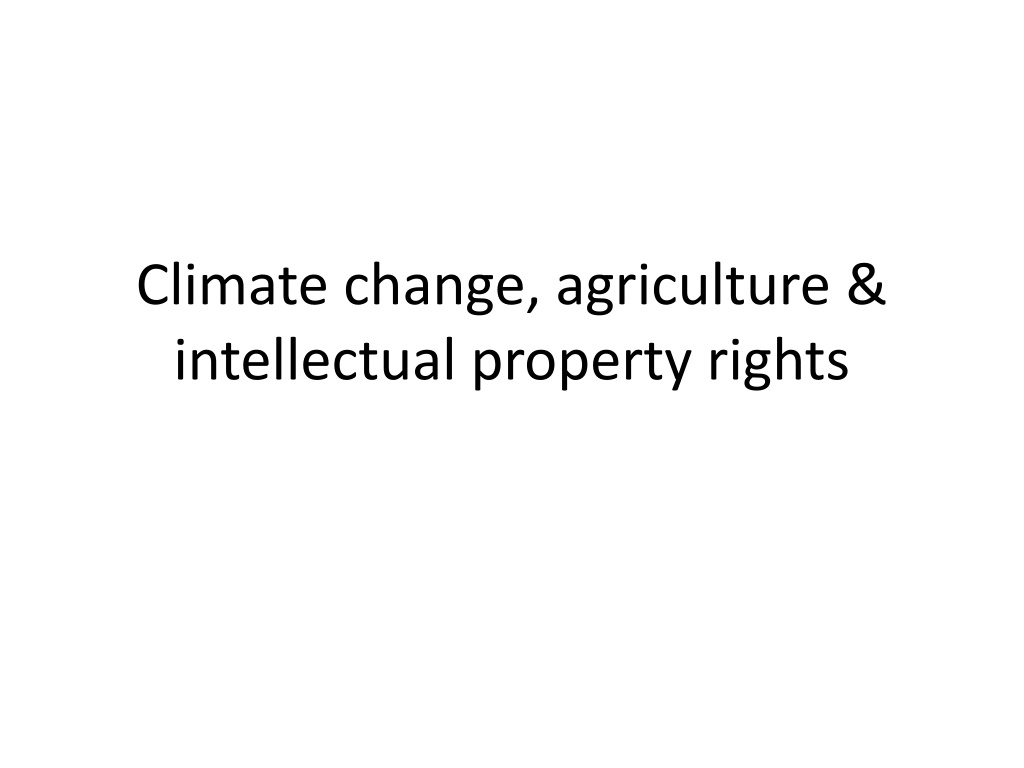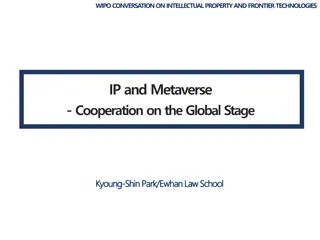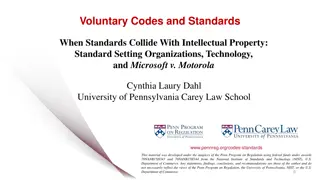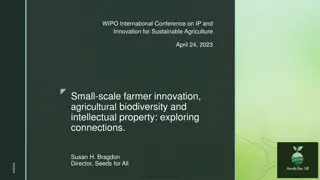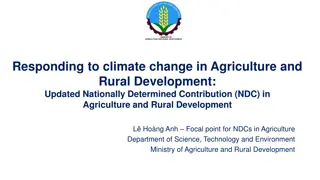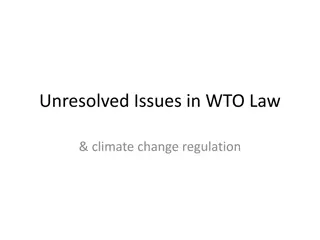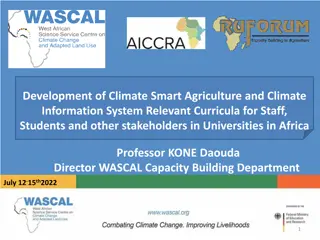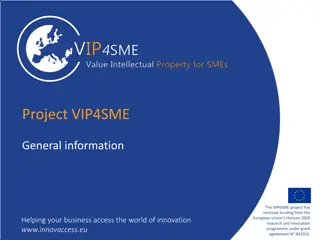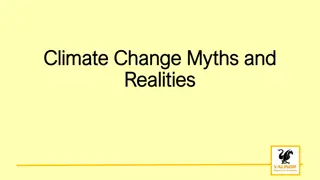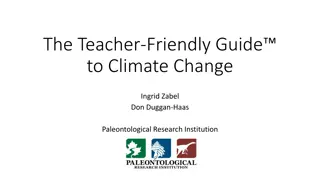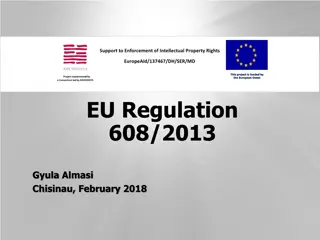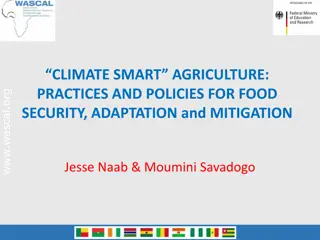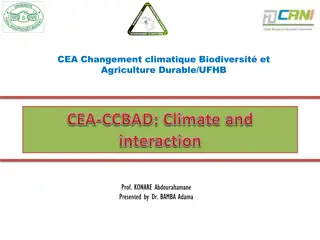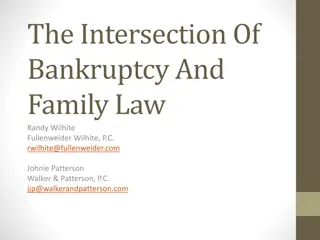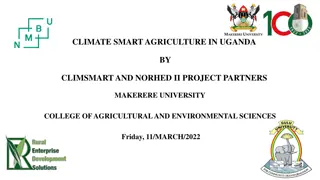Challenges at the Intersection of Climate Change, Agriculture, and Intellectual Property Rights
The impacts of climate change on agriculture and the implications for intellectual property rights are explored in this content. Extreme weather events and rising temperatures are creating challenges for farmers, particularly those in developing countries who rely on subsistence agriculture. The economics of GMO crops present barriers for small-scale farmers, raising questions about access to technology and the role of intellectual property rights in technology transfer debates.
Download Presentation

Please find below an Image/Link to download the presentation.
The content on the website is provided AS IS for your information and personal use only. It may not be sold, licensed, or shared on other websites without obtaining consent from the author. Download presentation by click this link. If you encounter any issues during the download, it is possible that the publisher has removed the file from their server.
E N D
Presentation Transcript
Climate change, agriculture & intellectual property rights
Climate change & agriculture Extreme weather becoming more extreme But a general rise in temperature This will stress marginal farmers i.e. Food security problem
Economics of GMO crops In poor countries between 80 and 90 percent of all farmers are subsistence farmers The majority has less than 3 hectres GMO seeds cost around US$600 But these (non reproducible) seeds require another US$1,400 of nitrate Those marginal farmers live under $2 a day They will not be able to afford to use them If they could, they would have generated a better living for them US $5,600-1,400-600=$3,600
IPRs and technology transfer Debated in many forums: UNFCCC WIPO WTO Regarding mainly: Clean energy technology Other environmental technologies Biotechnology = environmental technology
IPRs and biotechnology transfer Also debated in many forums: UPOV WIPO WTO Convention on Biological Diversity International Treaty on Plant Genetic Resources for Food and Agriculture IPR issues more akin to pharmaceuticals than clean energy technology
Developing countries need GMOs (+) impact of climate change on agriculture (-) viability of traditional plant varieties (+) need for GMO seeds (+) % of population depends on agriculture (+) depend on subsistence agriculture (+) rely on seeds from traditional varieties GMOs raise yields & adapt to climate change
Developed countries have GMOs GMO crops owned by Monsanto: 91% of soy 97% of maize 63% of cotton 59% of canola DuPont, BASF, Monsanto, Syngenta, Bayer and Dow have patented 77 % of climate ready crop genes
TRIPS Article 66.2 Technology transfer Obliges developed to create incentives for tech transfer to least developed countries Imprecise regarding: specific outcomes kinds of incentives Hard to enforce vague obligation No obligation regarding developing countries
TRIPS Article 27.1 Requires that patents be available for: any inventions ; whether products or processes; and in all fields of technology, If they meet 3 requirements: new ; involve an inventive step ; and capable of industrial application .
TRIPS 27.1 Requires WTO Members to: make patents available and patent rights enjoyable without discrimination as to: the place of invention; the field of technology; and whether products are imported or locally produced.
TRIPS Article 27.2 Permits exclusion from patentability: to prevent commercial exploitation necessary to protect ordre public or morality, including to protect human, animal or plant life or health or to avoid serious prejudice to the environment. GATT Art. XX jurisprudence relevant (Internet Gambling case Antigua vs US)
TRIPS Article 27.3(b) Permits Members to exclude from patentability plants and animals other than micro-organisms, and essentially biological processes for the production of plants or animals other than non-biological and microbiological processes.
TRIPS Article 27.3(b) Requires Members to provide for the protection of plant varieties either by: patents or an effective sui generis system or any combination thereof.
Article 27.3(b) WTO Negotiations How to judge the effectiveness of a sui generis system? Interpret effective in light of TRIPS obligations regarding enforcement of IPRs? Relationship between TRIPS, UPOV Convention and Convention on Biological Diversity.
Patents vs. Sui generis Patents: new ; involve an inventive step ; and capable of industrial application . Cannot patent existing plant varieties because not new . Sui generis: effective Can protect existing plant varieties
Patents vs. Sui generis Patents: Not available for existing varieties, they are not new UPOV: Ditto Sui generis: Existing varieties CAN be protected under efficiency argument
Patents vs. Sui generis India has a sui generis system Medicinal use of turmeric registered With this, India could attack US patents over medicinal use of turmeric U of Mississippi patented turmeric for using healing wounds U.S. Patent #5,401,504
Patents vs. Sui generis Patents can exclude from patentability under 27.2 27.2 covers plants and animals Sui Generis 27.2 only applies to patents, but sui generis could incorporate equivalent Members have debated exceptions that would be appropriate in a sui generis system: experimental use breeders' exemption
Monsanto Canada Inc. v. Schmeiser (Canada) Cannot patent plants Majority: Can patent genes and modified cells Minority: Cannot patent genes and modified cells because part of plant
UPOV Convention 1961, 1972, 1978 and 1991 WTO Members disagree whether UPOV 1991 is best sui generis system Some Members have their own sui generis systems with different lengths of protection
UPOV 1991 Breeder's right shall be granted where variety is: new, distinct, uniform and Stable. Difficult to apply at molecular level in biotechnology
Should countries require novelty? India: tumeric medicinal application Not having a novelty requirement enables the government to protect plant varieties that nationals have long used for traditional purposes. Prevents outside investors from patenting those plant varieties in their own countries by providing evidence of lack of novelty in the particular use of the plant.
UPOV 1991: compulsory exceptions to the breeder's right (i) acts done privately and for non-commercial purposes, (ii) acts done for experimental purposes, and (iii) acts done for the purpose of breeding other varieties (the breeder s exemption)
UPOV breeders exemption Affected by technological advances. New "reverse breeding" techniques shorten the time needed to create new varieties. Shortens original breeder s de facto period of exclusivity. Proposals to phase in the breeder s exemption according to the time it takes to reverse breed new varieties: Similar to increasing patent term for pharmaceuticals Appear designed to extend monopolies that would limit access.
UPOV farmers' exemption UPOV 1978 allows farmers to save, exchange and sell some seeds. UPOV 1991 lets government decide whether to permit farmers to save seeds for use on their own holdings, subject to "reasonable restrictions" and the protection of the "legitimate interests" of the breeder. UPOV 1991 exception only applies to material harvested on the same holdings and not propagated material. UPOV 1991 does not benefit farmers in the case of GMO varieties with terminator technology. UPOV 1991 would have a negative impact on food security and create dependence on foreign commercial breeders for seeds.
Compulsory licensing May restrict breeder's right only for reasons of public interest. Compulsory license under TRIPS Art. 31 should qualify. Ensure that the breeder receives equitable remuneration : When authorizing a third party to perform any act for which the breeder's authorization is required (UPOV 1991), When made in order to ensure the widespread distribution of the variety (UPOV 1978)
Equitable remuneration Monsanto Canada Inc. v. Schmeiser Monsanto chose an account of profits, rather than damages. Majority compared Schmeiser s profit attributable to the invention and Schmeiser s profit had they used ordinary canola. No difference in profits Monsanto entitled to no money on their claim.
TRIPS, UPOV & biotechnology Better balance of rights of producers and users of biotechnology in TRIPS than UPOV 1991. UPOV 1991 favors plant breeders more than farmers. UPOV 1991 more restrictive than TRIPS Articles 27.2 and 31. But sui generis more flexible than TRIPS.
Convention on Biological Diversity
Convention on Biological Diversity CBD focus on sovereign rights over genetic resources & informed consent. Difficult to apply in practice. Regulatory competition between: developed countries' patent-based systems & developing countries' sovereign-based systems. Both may restrict access and innovation.
Change & obsolescence Convergence of climate change, technological change, and economic change make current debates regarding IPRs and access to technology obsolete. IPRs hamper innovation. Technological change hampers IPRs. One-size-fits-all approach to IPRs for biotechnology is inappropriate.
Keep Article 27.3(b) flexible! TRIPS Article 27.3(b) flexibility: Expands policy options in face of uncertain impact of climate change on food security and environment. Facilitates avoiding conflicts between TRIPS, UPOV and CBD. Facilitates evolutionary interpretation to take into account changing environmental conditions and changing technologies.
